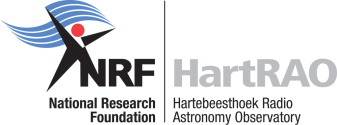
HartRAO Home >
HartRAO 26m telescope bearing repair
HartRAO 26m telescope bearing repair
On 2008 October 3rd at 13h23 SAST, the 26m antenna suffered a failure of the major bearing
at the southern end of the main polar drive shaft. The antenna
was driven to the safe stow position at zenith. No other structural
damage occurred. The antenna remained drivable in Declination and has been
operated in a limited way as a transit instrument to help ensure all its
operational systems remain functional.
The polar shaft supports all two hundred tonnes of the moving structure
above it and so to extract and replace the bearing is a major job involving
partially releasing the structure above the shaft and lifting it in order to
extract the faulty bearing and to examine the damage in detail.
After the problem occurred, several teams of engineers were brought
in to examine and cost rectification strategies.
We discovered that the Sister NASA
antenna DSS61 at Madrid, Spain suffered a similar problem in 1993 and was
successfully returned to service.
National and International Context
As well as being used for local astronomical programmes (mostly studies of
cosmic masers and pulsars, but also other objects), the antenna is used in
several international programmes of Very Long Baseline Interferometry (VLBI)
- an observational technique to combine telescopes, worldwide, to form the
equivalent of one large telescope with a diameter approaching that of the
Earth. HartRAO is favourably placed geographically to be part of several
such VLBI arrays. Two of these are the European VLBI Network and the Australia Telescope Long Baseline
Array, which are used mainly for high resolution studies of astronomical
objects. In 2008 the Hartebeesthoek 26m telescope started participating in
e-VLBI, i.e. connecting the radio telescopes in real time through the
internet. The aim of this is to permit rapid response to targets of
opportunity. We are also looking towards VLBI with an antenna in orbit
around the Earth, a technique called Space VLBI, and we are in discussion
about building a South African tracking station for a Japanese led Space
VLBI project. It is particularly aimed at high resolution studies of
quasars.
In addition to this purely astronomical function, the telescope operates as
part of a global array of radio
telescopes used for Geodetic measurements of the Earth's crustal motions
and the general parameters of the Earth's motion as it wobbles in its orbit.
Operating in this way, the telescope became the reference datum for the
country's survey system.
The Geodetic measurements have applications in accurate satellite orbit
determination by laser, and GPS position measurement for a broad variety of human
activities, for example monitoring technical construction and deformations
of structures such as bridges and dams, navigation for airlines, monitoring
natural phenomena like volcanoes, stress levels for earthquake hazard
assessment, and refining our models of sea level change. This means that
continuity of measurement is important.
The Hartebeesthoek antenna has also been a critical element in the
astrometric VLBI array of telescopes maintaining and extending the
International Celestial Reference Frame, especially for the far southern
skies that are not accessible to northern radio telescopes. Only a few
southern hemisphere radio telescopes are available for this programme, and
the unavailability of the 26m telescope has been a critical loss. Dirk
Behrend, the IVS Coordinating Center Director, commented on this issue in the
December 2008 IVS Newsletter.
Contingency Plan
We are fortunate that the prototype eXperimental Development Model (XDM) for
the Karoo Array Telescope (KAT), which is being developed by the South African SKA Project, was built on
the HartRAO site in 2007. XDM is a 15m diameter radio telescope. It was
designed for 1.5 GHz (20 cm wavelength) operation, but it has been tested
and shown to be usable at 12 GHz (2.5cm).
A dual-frequency 2.3 + 8.4 GHz (S-X) receiver system is being developed for
XDM by HartRAO to take over part of the geodetic VLBI programme from the 26m
telescope.
Repair of the 26m Telescope
A meeting of local stakeholders was held at the SA SKA Project Rosebank
office on 2009 July 22 to discuss the future of HartRAO and the 26m
telescope. By this time cost estimates had been obtained for the repair of
the telescope and for the construction of a comparable new telescope; the
first option was
much cheaper. Written representations were also obtained from a number of
international stakeholders. The decision taken at the meeting was that the
26m telescope should be repaired, the aim being for it to operate for at
least another ten years. This period was set by the timescale for any new
geodetic station with radio telescope, SLR, GNSS receivers etc. to be
accepted as a fiducial point. The aim was that any long-term replacement
radio telescope intended for geodetic VLBI should comply with the VLBI2010
specification.
Financing for the repair through the NRF infrastructure renewal fund was
obtained on 2009 October 30. The request for an order to repair the
telescope by an international engineering company and its local partner was
signed by HartRAO MD Roy Booth on 2009 November 25. Detail design work
commenced on 2010 January 11. Anticipated return to service date is circa
mid-2010. Following the July 22 decision to repair, the cryogenic microwave receivers
are being cycled through a refurbishment programme and other updates carried out.
On-site work for the repair began in 2010 March, with the moving of the
air-conditioning chiller plant from under the antenna. Contractors began
work on site on March 23.
Hartebeesthoek Radio Astronomy Observatory
P.O.Box 443, Krugersdorp 1740, South Africa
http://www.hartrao.ac.za
Phone: +27 (12) 326-0742/6/7
Fax: +27 (12) 326-0756
